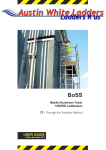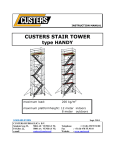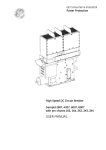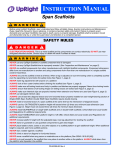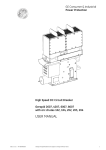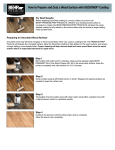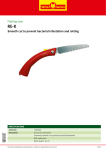Download MetalTech M-MWB42 Instructions / Assembly
Transcript
Wall bracket INSTALLATION INSTRUCTIONS 1. Read and understand instructions and warnings before proceeding with the installation. 2. Be sure building structure is stable and all the walls are completely erected and secured. 3. The brackets should be a distance of 10’ (3 m) maximum, center to center. 4. Install a spacer between the inner side of the wall and the bracket elbow to prevent any movement. 5. The bottom rail of the bracket must overlap at least two studs, one on both sides of the central section of the support. Fasten the bottom rail to the studs with #10 x 2 1/2" (6.5 cm) screws or 3 1/2" spiral nails. 6. Install a scaffold plank deck. Use 2" x 10" x 12’ (5 cm x 25 cm x 3.65 m) Certified planks. The planks must overlap at least 1’ (30 cm) on each side of the brackets. 7. Install guardrail post and lock it using the locking pin provided or use a 3/8" x 2" (0.95 x 5 cm) bolt with nut. 8. Install a toeboard using 2" x 10" x 12’ (5 cm x 25 cm x 3.65 m) scaffold plank. Toeboards must overlap at least 1’ (30 cm) on each side of the brackets. 9. Install a top and lower rail using 2" x 6" x 12’ (5 cm x 15 cm x 3.65 m) planks. Top and lower rails should overlap at least 1’ (30 cm) on each side of the brackets. 10. Each installation step must be executed safely and in accordance with federal, state or provincial (CSST) and municipal regulations. 11. During disassembly, do not let wall bracket components fall on the ground. 12. After each use, perform a visual inspection to ensure proper functioning and integrity of all components of the bracket. Do not use equipment if not in good condition. ______________________________ warning FAILURE TO UNDERSTAND AND FOLLOW ALL SAFETY RULES AND ASSEMBLY INSTRUCTIONS COULD RESULT IN SERIOUS INJURY OR DEATH. USER ASSUMES RISK OF PERSONAL INJURY BY FAILURE TO READ AND FOLLOW MANUFACTURER’S SAFETY RULES AND ASSEMBLY INSTRUCTIONS, AND BY FAILURE TO OBSERVE FEDERAL, STATE OR PROVINCIAL AND MUNICIPAL CODES. A wall bracket must be erected, altered, and dismantled by qualified workers or under the direct supervision of a qualified person. The qualified person must ensure that the erection is carried out properly, and that the correct components and materials are being used. All equipment must be inspected before use to make sure that it is in good repair, the integrity of all it components and suitable for the intended use. Be sure the building structure is stable and all walls are completely erected and secured to prevent movement of the structure. When assembling or disassembling the platform, each worker assigned to this operation must be secured by a safety harness system equipped with a shock absorption system connected to a lanyard that does not allow a free fall of more than 4’ (1.2 m). Always use in accordance with local regulations. First mark out a working area on the ground with continuous barricades and place signs prohibiting access to this area. - All the brackets must be stable, level and securely fixed to the wall to prevent movement of components. All scaffolding plank and lumber used shall conform to CAN/CSA - S269.2-M87 or OSHA 1926.451 or ANSI A10.8-2001. The wood must be free from rotting, cracking, burning or deformations. Top and middle rail must be installed on all open sides of the platform where a person could fall a distance of 10’ (3 m) or more. All guardrail posts must be secured to the bracket using locking pins or bolts with nuts. Do not stand on or place loads on top rails. Toeboards must be installed on all the open sides of a working platform where it is possible for tools and or materials to roll off. The top of the toeboard must be at least 10” (25 cm) above the platform. If loose materials are to be stacked above the height of the toeboard, mesh panels must be installed to prevent materials from falling off the working platform. _________________________________ Maximum load capacity: 1,000 lbs / 454 kg __________________________________ Metal conducts electricity. DO NOT USE WITHIN 10’ (3 m) OF NON-INSULATED, LIVE ELECTRICAL WIRES OR DEVICES.



